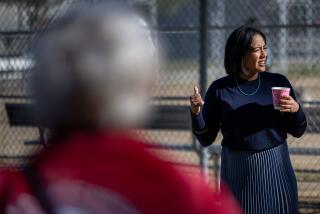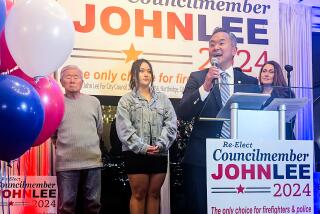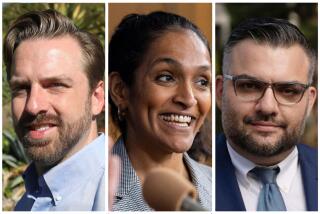Candidates vying for Tom LaBonge’s seat try to break out of the pack
The campaign in an eclectic, recently redrawn City Council district that stretches from the Miracle Mile to Sherman Oaks is shaping up as Los Angeles’ most unpredictable election this year.
Fourteen candidates are vying to replace 4th District Councilman Tom LaBonge, who will soon be termed out of office. Experts say the crowded field offers a rare chance to any contender who is able to cobble together the few thousand votes that will probably be needed to advance to a May runoff.
With no incumbent and no clear front-runner, City Hall watchers say it’s unusually hard to guess who will emerge to represent a sprawling array of some of L.A.’s more affluent and politically engaged neighborhoods.
Details on the 14 candidates for 4th District City Council seat
“You’ve got a lot of people here who have a chance,” said Raphael Sonenshein, executive director of the Pat Brown Institute for Public Affairs at Cal State Los Angeles. With a number of strong contenders, he said, “the unpredictability level just explodes. “
So far, it’s been a struggle for the candidates to stand out. Several have government experience, including former state legislator Wally Knox, City Council aides Carolyn Ramsay and Joan Pelico, former mayoralaide Teddy Davis and Steve Veres, who works as Los Angeles director for state Sen. Kevin de León.
But none have the kind of name recognition that could quickly separate them from the field. Some are playing up their outsider status — but that political space also is packed.
More than $1.5 million has been raised by the candidates as of last week. David Ryu, a community health center development director, led the field with more than $300,000 in contributions. Close behind were Ramsay and Veres, who raised more than $200,000. Knox was near that mark.
Debates have focused on familiar issues of traffic, development and city finances. Candidates have staked out a range of positions on such questions as the future of a gross receipts tax reviled by many businesses and boosting the citywide minimum wage.
Overall, however, “there’s no wedge issue,” said Fernando Guerra, director of the Center for the Study of Los Angeles at Loyola Marymount University. “They all agree — we want crime down, traffic to be calmer, development to be under control.”
Simple mathematics could produce a surprise victory, political analysts say. Voter turnout in the March primary is expected to be low. With so many candidates splitting the vote, one might be able to advance to the May runoff election with just a few thousand ballots cast for them.
“You don’t need that many,” Guerra said. “And I doubt that anyone is going to get more than 30% of the vote.”
Two years ago, a dozen candidates competed to replace Eric Garcetti in the council district stretching from Atwater Village to Hollywood and Echo Park. The two contenders who made it to the runoff each received less than 20% of the votes cast — roughly 4,000 to 4,500 apiece.
Experts say that number of votes could be assembled by a primary election candidate with a limited but committed group of backers. “A candidate who can turn out a small group of passionate voters with a particular issue, or by a particular neighborhood, is in a much better position than one who tries to appeal more broadly,” said Dan Schnur, executive director of USC’s Jesse M. Unruh Institute of Politics.
That could be good news for candidates with less campaign cash and fewer City Hall political connections, such as Los Feliz nonprofit director Tomas O’Grady, who previously challenged LaBonge, or Jay Beeber, an activist who battled against the city’s now-defunct red-light camera system.
Also running are businesswoman and economist Sheila Irani, marketing executive Fred Mariscal, Tara Bannister of the National Apartment Assn., vapor bar owner Step Jones, small business owner Ross Sarkissian, and self-described public interest advocate Mike Schaefer.
Steve Erie, a political science professor at UC San Diego, said the low vote totals needed to make it into the runoff could foster a “balkanization of the district in terms of the candidates — the Sherman Oaks candidate, the Los Feliz candidate.”
That could prove particularly significant in the new, far flung 4th District, which Erie dubbed “a collection of neighborhoods in search of a district.” At a recent candidates forum in Sherman Oaks, residents and candidates alike groused about the odd assortment of communities stitched together in the most recent redistricting.
Richard Close, president of the Sherman Oaks Homeowners Assn., said that “dynamic of a divided district” could prove critical in the primary. “There’s a tendency for Sherman Oaks residents to vote for someone who lives in Sherman Oaks.... No one affects your neighborhood more than your city council member,” Close said. “People realize that.”
With a crowded ballot, endorsements could take on extra importance, analysts said. LaBonge is backing Ramsay, his former aide, and the county Democratic Party recently gave its nod to Veres. The county labor federation, another influential group, does not plan to back a candidate until after the runoff campaign.
“The head of a homeowner group could matter, because all of the voters are going to be scratching their heads saying, ‘I don’t really know,’” said Steve Afriat, president of Afriat Consulting Group, which is not working with any of the candidates in the race.
The difference between winning and losing, Guerra said, may simply boil down to whether “the voter actually heard the name before.”
More to Read
Start your day right
Sign up for Essential California for news, features and recommendations from the L.A. Times and beyond in your inbox six days a week.
You may occasionally receive promotional content from the Los Angeles Times.







